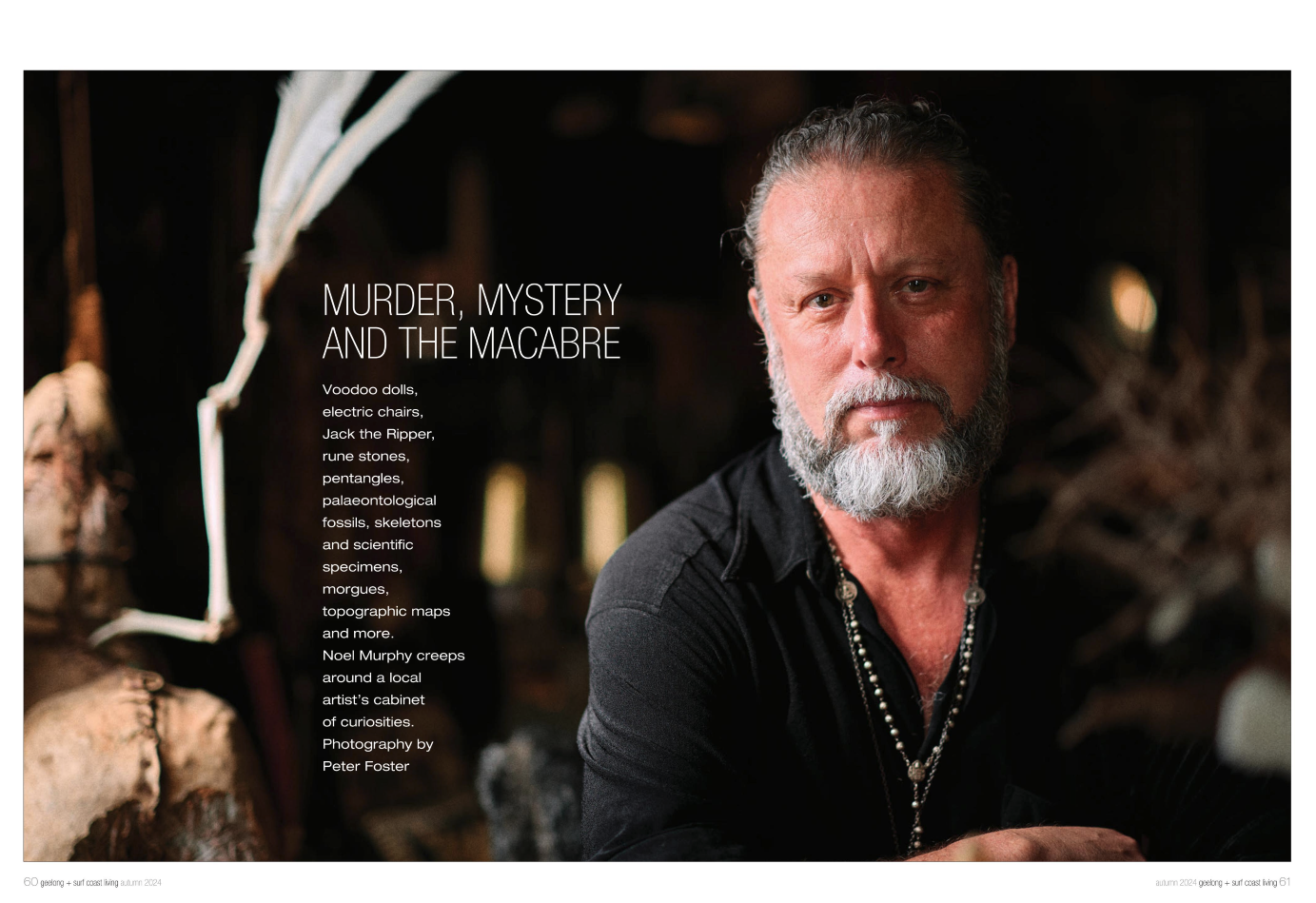
Voodoo dolls, electric chairs, Jack the Ripper, rune stones, pentangles, palaeontological fossils, skeletons and scientific specimens, morgues, topographic maps ….
As soon as you think you have a handle on Geelong artist Andrew Delaney’s work, it morphs into another eerie chronicle of the shivery and everyday about us. Women and lace, gold and cotton and pearls, skulls, body parts, syringes, alchemy, formaldehyde, poison, mummies, dinosaurs … all with an elegant discomfort.
It’s dark, often dripping with a foreboding suspense. It can persecute any sensitivities you might harbour from childhood faerie tales, goose-flesh cinema or Ripley’s Believe It or Not. Kind of like Vincent Price meets Dali, Hitchcock, the Brothers Grimm and Patrick White’s vivisector.
Andrew’s Anno Domini Home 19th century cabinet of curiosities, housed in an old Geelong warehouse, is melded with all manner of poignant, insightful, even cathartic, observations of the world and humanity. It’s Gothic with all its mystery, horror, romance and gloom, but it’s arrestingly beautiful, too. Skilful, adroit, esoteric …
A conversation with him is equally wide-ranging. Everything from shrunken heads, strait-jackets, witches and superstitions to Harry Houdini, horror movies, padded cells and funerals. It’s not maudlin, though. He’s very much about art and people, inspiration and growth.
“Victoriana certainly has its aesthetics, it’s wonderfully dark and interesting and relates to our history, and we do have a very dark history,” Andrew says. “I’m not sure why I align with it but it explores the human psyche whereas we tend to glide over death and loneliness and loss these days.
“In the 19th century, they coped with psychological effects really well. A funeral wasn’t just a three- day pop-them-in-the-ground affair, there was a real process. Infant mortality rates were so high, death was reflected in what they wore, in jewellery, stationery, art, memorials, portraits, old wives’ tales, superstitions.
“I love the folklore, the mythology and belief behind all of that. It doesn’t matter to me if it’s Catholic or darker. A lot of people have taken the time to trace their family roots and the heritage of their early beliefs – they’re no longer evil things and often relate to your ancestry.”

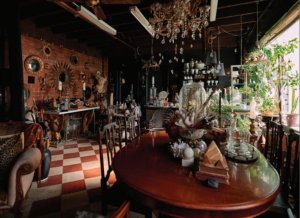
Andrew’s work is singular for its use of textiles, of vintage and unwanted fabrics, to explore life’s vulnerabilities and our mortality. Layers of fabric become flesh and bone, muscles and sinew. They become marine specimens, chillingly realistic laboratory and medical specimens.
People don’t always see fabric art as a permanent art form, he says. Yet exhibitions of, say, costumes belonging to celebrities or historical figures hold huge appeal for audiences, offering a single degree of separation from the real humanity of the famous, or infamous for that matter.
“Most of the fabrics are old and recycled,” he says. “I will work with natural colours of stuff, try not to alter them too much and I’ll highlight the holes, bring things to the front to tell us it’s worn, an old piece.
“It’s a bit of a ploy so people think of the story and ask questions. It taps into their nostalgia, what they’ve seen or heard. Instead of putting explanatory cue cards to the side of the works, I’d rather get 20 questions, and they give me back something.”
His work also has a lighter, playful side as well. His recent Darwin: A Reimagining exhibition at Creative Geelong’s Third Space Gallery + Digital on Little Malop, in the heart of Geelong, was predicated on the mischievous proposition that a young Charles Darwin, aboard The Beagle in Hobart in 1836, left behind several crates of specimens and journals.
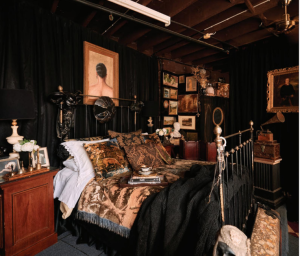
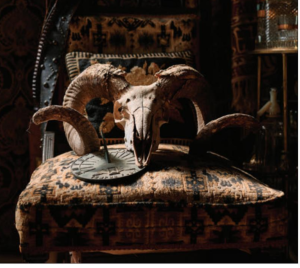
A purported dockside redevelopment unearthed a vault untouched for 180 years, inspiring Andrew’s take on evolution, our origins and the nature of faith. This treasure chest included fossils, chessboard dinosaurs challenging creationist Christian authorities, monkeys, skulls, moa eggs – an emporium of ape-men, skeletons, marine and bottled specimens, logbooks, topographic maps, microscopes, plants, squid.
Andrew was born in the Western District, studied photography, technical and life drawing, graphics at the Melbourne College of Decoration. He’s worked as a stylist/visual merchandiser in fashion, homewares, craft, cosmetics. Also as a corporate events art director and stylist with sewn objects, scenic painting, finished art, floral renderings, mood boards, photo-shoots, TV commercials …
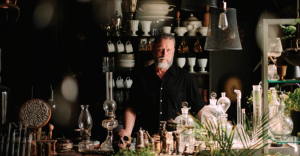
He’s presently working with, among others, Creative Geelong’s May’d Art Festival and looking to bolster Geelong’s rich creatives community. He sees Geelong’s UNESCO City of Design status as an important driver of its broad art and culture spectrum.
He says Little Malop, with its institutional art gallery, heritage centre and library to the west, its food and music outlets in its centre, and burgeoning grassroots art precinct to the east, is a critical player in developing and celebrating Geelong’s arts.
Andrew’s part in that might seem a bit back to the future but if Jack the Ripper can’t get people revved up, who can?
This article appeared in Geelong + Surf Coast Living magazine, autumn edition 2024.


